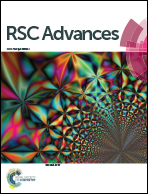Fabrication of rapidly-responsive switches based on the coupling effect of polyacrylamide and poly(acrylic acid) without IPN structures
Abstract
Interpenetrating polymer network (IPN) structures have been applied in stimuli-responsive drug delivery systems. However, these structures may restrict the stimuli-responsive speed. In this paper, the traditional IPN structure was not applied and a novel coupling system, comprising two different polymers, polyacrylamide (PAAM) and poly(acrylic acid) (PAAC), immobilized onto different membranes, was studied for the first time. The formation and microstructures of the immobilizing membranes were investigated systematically by XPS and SEM. The thermoresponsive characteristics of the coupling membrane systems were investigated by tracking the diffusional permeability of NaCl at temperatures from below the upper critical solution temperature (UCST) to above the UCST. The results show that PAAM and PAAC were successfully immobilized onto the porous N6 membrane substrates. The proposed systems have positive switch effects with higher responsive speeds under the same conditions. The data provide valuable guidance for increasing thermoresponsive speeds and the design and preparation of new thermoresponsive switch membrane systems for different applications.


 Please wait while we load your content...
Please wait while we load your content...